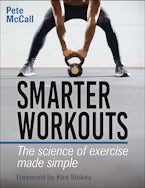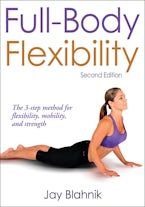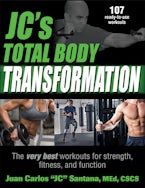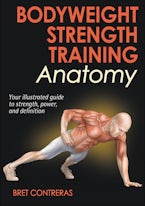
No equipment necessary for these workouts. Cardio, resistance, yoga, and more
Solutions for home workouts: how to get started
Pete McCall, C.S.C.S, author of Smarter Workouts, shares tips on at-home workouts and how to get started.
Balancing your workouts
Michelle Maloney, Human Kinetics Senior Acquisitions Editor, discusses:
- How to balance your workouts to address all areas of fitness
- What activities you can use to develop each facet of fitness and resources you can use
- Examples of what a balanced 1-week workout schedule looks like
Examples of sample workouts:
Bodyweight circuits
Check out these lower and upper bodyweight circuits from Bodyweight Strength Training Anatomy which can be done without use of any equipment.


5-10-5 and Reach Out circuits



Chisel your chest workout 1
This 8-week program is made up of two monster workouts (see other workout here); one made it into an issue of Men’s Health. You can treat each 4-week phase as a separate protocol and even go for the elite version if you like. Just to be able to do either one of these protocols with little to no rest between each exercise is an accomplishment. This strategy of metabolic chest training even has some solid research behind it as well. Dr. Rhadi Ferguson presented his findings on a 3-week version of this protocol for his PhD dissertation (Ferguson, Rhadi. 2009. Use of the medicine ball super arms protocol on the National Football League’s 225-lb repetition-to-failure bench press test: Analysis of effects. A dissertation presented in partial fulfillment of the requirements for the degree doctor of philosophy. Capela University), showing a 5.2% increase in the 225 lb (102 kg) bench-press-to-failure in elite football players in 3 weeks, without lifting a weight! The tempo is very fast, approximately 1-2 repetitions per second, so the entire protocol is done in about 50-60 sec. Weeks 1 and 2 will be enough for most people, while weeks 3 and 4 should be attempted only by elite athletes or individuals who have years of training behind them.

Chisel your chest workout 2
This 8-week program is made up of two monster workouts (see other workout here); one made it into an issue of Men’s Health. You can treat each 4-week phase as a separate protocol and even go for the elite version if you like. Just to be able to do either one of these protocols with little to no rest between each exercise is an accomplishment. This strategy of metabolic chest training even has some solid research behind it as well. Dr. Rhadi Ferguson presented his findings on a 3-week version of this protocol for his PhD dissertation (Ferguson, Rhadi. 2009. Use of the medicine ball super arms protocol on the National Football League’s 225-lb repetition-to-failure bench press test: Analysis of effects. A dissertation presented in partial fulfillment of the requirements for the degree doctor of philosophy. Capela University), showing a 5.2% increase in the 225 lb (102 kg) bench-press-to-failure in elite football players in 3 weeks, without lifting a weight! The tempo is very fast, approximately 1-2 repetitions per second, so the entire protocol is done in about 50-60 sec. Weeks 1 and 2 will be enough for most people, while weeks 3 and 4 should be attempted only by elite athletes or individuals who have years of training behind them.

Plank and crunch abs
This workout is an excellent choice for use as a home or travel workout, especially if you don’t have too much time to train.
Since this workout uses plank positions, it may be challenging for people who suffer from wrist issues. If you are one of those people, use push-up handles to help you position your wrists in a more neutral pain-free position. Another option to make the training a little less intense on the wrists and core, but still get good abdominal work, is to use a box or a bar to elevate the push-up position.

Triple threat
The triple threat is a combination of three stability ball exercises in succession, consisting of the stability ball bridge, the stability ball leg curl, and the stability ball hip lift. This protocol keeps constant tension on the hamstrings by requiring the hips to come up and remain off the floor during the entire protocol.

8 vital core exercises for cyclists to boost power and speed
A strong abdominal core is essential to cycling fitness. We’ve put together 8 of the best core exercises for cyclists to help you improve power and speed.
As cyclists develop such strong back muscles from their position on the bike, it’s important to counterbalance this with a strong anterior. The back is strengthened naturally due to the time cyclists spend bent forward over their handlebars. However, this can cause asymmetry. Your back becomes stronger than your abdomen and core, which can cause a few issues. This means building a stronger core is essential. In this blog post, adapted from Cycling Anatomy, 2nd Edition we’ve put together 8 vital core exercises for cyclists.

Strength exercises for golf: Increase drive distance and improve your game
Determining the level of strength a player needs to play at their best is difficult. Some of the longest hitters on the PGA Tour wouldn’t be considered overly impressive at the gym. Yet, some smaller players are still able to create top club speeds and move the ball long distances. How is this possible? In this blog post, we’re going to give you some strength exercises for golf from the latest edition of Golf Anatomy that can help increase your distance and improve your overall game.
Stretching routines



Mobility workout for feet, hips, spine, and shoulders
Experience the benefits of mobilizing the fascia network and improve functional mobility of the ankle/foot, hip, spine, and shoulders with this workout from Myofascial Training by Ester Albini.
Yoga Poses
Visit our Mind and Body Workout page for a series of Yoga Poses and many other resources!
Books featured
JC’s Total Body Transformation
The very best workouts for strength, fitness, and function
£20.99
9781492572763










